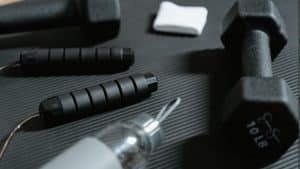Discover five effective dumbbell lower back workouts that strengthen your lower back and help prevent injury—so you can train harder, longer, and safer starting today. Lower back pain is one of the most common reasons people stop exercising. Yet ironically, strengthening your lower back is the best way to protect it from future pain. And guess what? You don’t need expensive machines or a gym membership. You just need a pair of dumbbells and the right form.
Let’s break down five of the best dumbbell lower back workouts—rooted in math, biomechanics, and muscle-building science.
Why Dumbbells Work for Lower Back Strength
Dumbbells challenge your balance, coordination, and stabilizer muscles in ways machines can’t. They force each side of your body to work independently, which improves muscle symmetry and corrects imbalances that often cause back pain.
Plus, with dumbbells, you can control your range of motion—a key factor in keeping your spine safe while still building strength and endurance.
1. Dumbbell Romanian Deadlifts (RDLs)
Primary muscles: Spinal erectors, glutes, hamstrings
This is the king of lower back dumbbell exercises. Keep your knees slightly bent, spine neutral, and hinge at the hips—not the waist.
How to do it:
- Hold dumbbells in front of your thighs.
- Lower them slowly by pushing your hips back.
- Keep the weights close to your legs.
- Return to standing by driving your hips forward.
📊 Why it works: RDLs apply eccentric loading to your hamstrings and erector spinae, which triggers hypertrophy and increases durability.
2. Dumbbell Bird Dogs
Primary muscles: Multifidus, glutes, core stabilizers
This movement turns your entire core into a dynamic brace while training your lower back to resist rotation and flexion.
How to do it:
- Get on all fours with a light dumbbell in your left hand.
- Extend your left arm forward and your right leg back.
- Pause at full extension.
- Slowly return and repeat.
🧠 Bonus tip: Perform this move slowly—control builds stability.
3. Dumbbell Suitcase Carries
Primary muscles: Quadratus lumborum, obliques, erectors
Carrying a dumbbell in one hand forces your core and lower back to fight lateral flexion.
How to do it:
- Pick up a heavy dumbbell in one hand.
- Walk 30–60 seconds while staying upright.
- Don’t lean—your lower back is resisting movement.
⚖️ Real-life application: Improves posture, spinal endurance, and protects against daily back strain.
4. Dumbbell Good Mornings
Primary muscles: Lower back, glutes, hamstrings
Good mornings simulate the hip hinge with added spinal engagement.
How to do it:
- Place dumbbells on your shoulders like a barbell.
- Hinge at the hips while maintaining a flat back.
- Pause when you feel a deep stretch in your hamstrings.
- Return to start using your glutes and back.
🚧 Caution: Start light to avoid rounding your spine.
5. Bent-Over Dumbbell Rows (With Strict Form)
Primary muscles: Lats, rhomboids, erectors
Though mainly a back exercise, bent-over rows train isometric strength in your lower back by keeping your spine stable under load.
How to do it:
- Bend over at the hips with knees slightly bent.
- Hold dumbbells under your shoulders.
- Row dumbbells toward your waist.
- Keep your spine in a neutral “tabletop” position.
🧮 Why it matters: Holding a hinged position while rowing builds static lower back endurance and resilience.
How Often Should You Train Your Lower Back?
Your lower back is part of your core—it benefits from 2–3 sessions per week of smart, controlled loading. Don’t go heavy every time. Rotate between:
- Strength sessions (RDLs, Good Mornings)
- Stability work (Bird Dogs, Suitcase Carries)
- Endurance training (Bent-Over Rows, long carries)
Key Takeaway
Stronger backs mean fewer injuries.
These dumbbell lower back workouts target the spine-supporting muscles that keep your posture strong and pain-free. Add 2–3 of these exercises to your current split, and over time, you’ll notice better performance, less fatigue, and most importantly—less lower back pain.
Start light, use perfect form, and build volume before intensity.
Subscribe now and get a 14-day free trial workout app for iPhone users.





